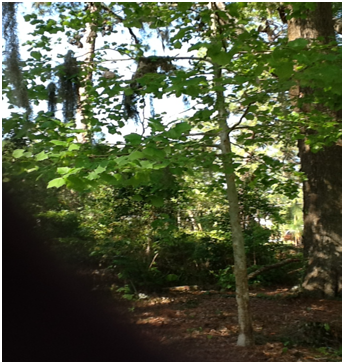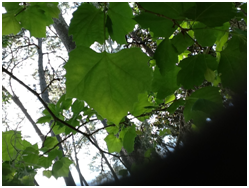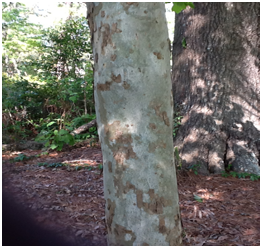Sycamore
Platanus occidentalis

(Photo by Talisa Placide)
View the Location on Campus
Taxonomy (1,2)
Classification: Angiosperm, dicot
Family: Platanaceae
Common name: Sycamore, Buttonwood
General Information (1,2,3)
Region of Origin: United States
USDA Plants Hardiness Zones: 4-9
Growth Habit: Tree
- Size: 75-100 feet
- Deciduous/Evergreen: Deciduous
- Flowering: Mid-spring
- Fruiting: Fall
Diagnostic Characteristics
Leaves (1)
- Arrangement: Alternate
- Simple/Compound: Simple
- Shape: Lobed
- Other: 4-9 inches, toothed margin

(Photo by Talisa Placide)
Stem/Bark (1)
- Color: Gray-brown to red, white underlayer
- Texture: Scaly

(Photo by Talisa Placide)
Flower (1,2,3)
- Perfect/Imperfect: Imperfect (Monoecious)
- Size: 0.5 inch
- Inflorescence type: Head
Fruit (1,3)
- Fruit type: Achenes
Horticultural Information (1,2,3)
- Light: Full sun to partial shade
- Soil type: Sandy
- Landscape Uses: Street trees, shade trees
- Other: Can handle poor drainage
Interesting Facts (3)
- Out of all native trees, the sycamore has the broadest trunk
References
1) Dirr, Michael A. (1990). Manual of Woody Landscape Plants. Champaign, Illinois: Stipes Publishing Company.
2) 2012. Plantanus occidentalis. Floridata. Retrieved from www.floridata.com/ref/p/plat_occ.cfm
3) Tim Mcdowell. ETSU Arboretum Tree Of the Week. Retrieved from http://www.etsu.edu/arboretum/totw.html
Prepared by Talisa Placide as a course requirement for BIOL 3630/5630, Spring 2013
Edited by Jessica Bartek
Edited by Jessica Bartek
Department of Biology
-
Room 2035, 2nd Floor
Bailey Science Building -
Mailing Address
1500 N. Patterson St.
Valdosta, GA 31698 - Phone: 229.333.5759
- Fax: 229.245.6585
Monday - Thursday
8:00AM until 5:30PM
Friday
8:00AM until 3:00PM
Saturday - Sunday
Office Closed